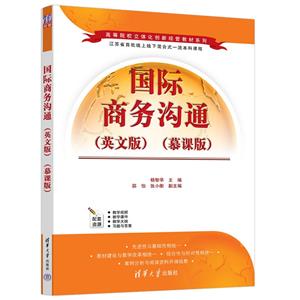-
>
以利為利:財政關系與地方政府行為
-
>
立足飯碗 藏糧于地——基于中國人均耕地警戒值的耕地保護視角
-
>
營銷管理
-
>
茶葉里的全球貿易史(精裝)
-
>
近代華商股票市場制度與實踐(1872—1937)
-
>
麥肯錫圖表工作法
-
>
海龜交易法則
國際商務溝通(英文版)(慕課版) 版權信息
- ISBN:9787302605324
- 條形碼:9787302605324 ; 978-7-302-60532-4
- 裝幀:一般膠版紙
- 冊數:暫無
- 重量:暫無
- 所屬分類:>>
國際商務溝通(英文版)(慕課版) 本書特色
《國際商務溝通(英文版)(慕課版)》以幫助學生掌握商務情境中的口頭和書面溝通技巧、了解多元文化在商務溝通中的影響、提高學生的跨文化溝通能力為主要目的。全書以情景導入,分析不同形式和目的的商務溝通技巧,重點內容輔以具體實例講解。利用現代信息技術將線上線下資源有機結合,打造立體化教學資源和全方位教學培訓。 國家慕課教材,配套資源豐富,有教學視頻、教學課件、教學大綱及習題與大綱等。
國際商務溝通(英文版)(慕課版) 內容簡介
《國際商務溝通(英文版)(慕課版)》以培養具有民族自信、靠前視野的中國聲音傳播者為目標,結合靠前商務溝通實踐的變化和現代信息技術工具的應用,詳細介紹了跨文化溝通基本知識和日常商務溝通、異議與索賠、商務報告、口頭演講、求職寫作與面試的思路和技巧。 為了盡可能地貼近靠前商務溝通實踐并滿足靠前化人才培養需求,《國際商務溝通(英文版)(慕課版)》正文采用全英文編寫,在靠前商務專業情境中,引導讀者從總體上把握跨文化溝通基本知識,深入理解商務溝通基本技巧和主要國家文化差異,并能夠應用于商務溝通實踐。針對重點和難點內容設計,選用了相關問題和案例,且配有豐富的在線課程資源和拓展閱讀資料。 《國際商務溝通(英文版)(慕課版)》既可以作為高等院校經管類專業本科生和靠前商務專業研究生學習靠前商務函電、靠前商務溝通、靠前商務英語等課程的教材,也可以作為靠前商務各領域從業人員的自學、參考書籍。
國際商務溝通(英文版)(慕課版) 目錄
Part 1 Basics of Business Communication
Chapter 1 Understanding Business Communication 3
1.1 Introduction to Communication 3
1.1.1 Definition of Communication 3
1.1.2 Elements of the Communication Process 3
1.1.3 Classification of Communication 5
1.2 Introduction to Business Communication 6
1.2.1 Business Communication Definition 6
1.2.2 Effective Business Communication 7
1.3 Verbal and Non-verbal Communication in Business 7
1.3.1 Verbal Communication 8
1.3.2 Non-verbal Communication 16
1.4 Visual Communication 18
Exercises 24
Chapter 2 Intercultural Business Communication 29
2.1 Introduction to Intercultural Communication 29
2.1.1 Understanding Cultural Differences 29
2.1.2 Cultural Differences in Non-verbal Communication 32
2.1.3 Definition of Intercultural Communication 34
2.2 Intercultural Communication Skills in Workplace 34
2.2.1 Barriers to Intercultural Business Communication 34
2.2.2 Effective Intercultural Communication in Business 37
Exercises 40
Part 2 Routine Business Communication
Chapter 3 Writing Business Letters 49
3.1 Elements of Business Letters 49
3.1.1 Essential Elements 49
3.1.2 Optional Elements 54
3.2 Formats of Business Letters 57
3.2.1 Basic Styles 57
3.2.2 Margins and Space 59
3.3 Envelopes of Business Letters 60
3.3.1 Contents and Formats of Envelopes 60
3.3.2 Etiquette of Folding a Business Letter 61
3.4 Guidelines for Writing Business Letters 63
3.4.1 Clarity 63
3.4.2 Conciseness 64
3.4.3 Correctness 65
3.4.4 Concreteness 66
3.4.5 Consideration 66
3.4.6 Courtesy 67
3.4.7 Completeness 68
Exercises 68
Chapter 4 Establishment of Business Relations 70
4.1 Finding Prospective Customers 70
4.2 Writing Letters to Establish Business Relations 71
4.2.1 Understand the Structure 72
4.2.2 Make Your Letter Easy to Read 74
4.3 Reach Your Customers Online 76
4.3.1 Company Profile 76
4.3.2 Description of Products or Services 78
4.3.3 Make Your Messages Online Appealing 78
Exercises 79
Chapter 5 Formation of Contracts 81
5.1 Negotiation for Contracts 81
5.2 Inquiry 82
5.2.1 Types of Inquiries 82
5.2.2 Typical Outline of Inquiries 82
5.2.3 Replies to Inquiries 83
5.3 Offer 85
5.3.1 Validity of Offers 85
5.3.2 Non-Firm Offers 86
5.3.3 Typical Outline of Offers 87
5.4 Counter-Offer 88
5.4.1 Typical Outline of Counter-Offers 88
5.4.2 Counter-Offer Letter Study 89
5.4.3 Useful Expressions 91
5.5 Acceptance 92
5.5.1 Countersignature 92
5.5.2 Orders from Buyers 93
5.5.3 Confirmation of Orders from Sellers 94
5.5.4 Return of Countersigned Contracts 96
5.5.5 Extended Skills: to Draft a Contract for International Sale of Goods 96
Exercises 99
Chapter 6 Claim and Resolution 102
6.1 Claim 102
6.1.1 Tips for a Well-organized Claim Letter 102
6.1.2 Claim Letter Study 103
6.2 Response to Claim 104
6.2.1 A Letter to Acknowledge the Receipt of Claim 104
6.2.2 A Letter to Favorably Resolve the Claim 105
6.2.3 A Letter to Unfavorably Resolve the Claim 105
Exercises 106
Part 3 Reports, Proposals and Presentations
Chapter 7 Business Reports and Proposals 111
7.1 Business Reports 111
7.1.1 Types and Writing Styles of Business Reports 111
7.1.2 Writing a Business Report 114
7.1.3 Components of Business Report 119
7.2 Proposals 128
7.2.1 Types of Proposals 128
7.2.2 Components of a Proposal 129
Exercises 132
Chapter 8 Oral Presentation 135
8.1 About Business Presentations 135
8.2 Making Effective Oral Presentations 137
8.2.1 Steps of Making a Presentation 137
8.2.2 Developing Presentation Skills 152
Exercises 156
Part 4 Employment
Chapter 9 Employment Messages 163
9.1 Build toward Career 163
9.1.1 Analyze What You Have to Offer 163
9.1.2 Make Yourself More Desirable to Employers 164
9.2 Create your Résumé 165
9.2.1 Plan your Résumé 165
9.2.2 Write Your Résumé 166
9.2.3 Polish Your Résumé 171
9.3 Customize Your Cover Letter 172
9.3.1 Solicited and Unsolicited Cover Letters 172
9.3.2 Online Application Form 176
Exercises 176
Chapter 10 Job Interview 179
10.1 Understand Job Interviews 179
10.1.1 Purposes of Job Interviews 179
10.1.2 Types of Job Interviews 180
10.2 Prepare for and Ace Job Interviews 182
10.2.1 Preparing for the Interview 182
10.2.2 During the Interview 190
10.3 Follow up Job Interviews 192
10.3.1 Follow-up Messages 192
10.3.2 Letters of Acceptance, Rejection and Resignation 194
Exercises 197
References 199
國際商務溝通(英文版)(慕課版) 作者簡介
楊智華,南京財經大學副教授,博士,美國賓州州立大學訪問學者。主持國家和省部級課程建設項目4項,主持和參與省級和校級教改課題10余項,出版教材3部。曾獲2019年教育部在線課程研究中心“智慧教學之星”,2017年江蘇省高等學校微課教學比賽二等獎、南京財經大學本科優秀教學教師稱號、教師教學公開賽一等獎、教學成果二等獎。
- >
史學評論
- >
詩經-先民的歌唱
- >
隨園食單
- >
龍榆生:詞曲概論/大家小書
- >
中國人在烏蘇里邊疆區:歷史與人類學概述
- >
【精裝繪本】畫給孩子的中國神話
- >
莉莉和章魚
- >
名家帶你讀魯迅:故事新編















